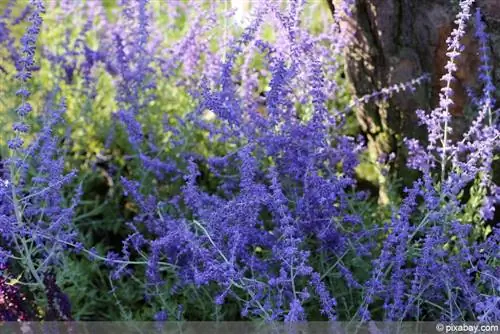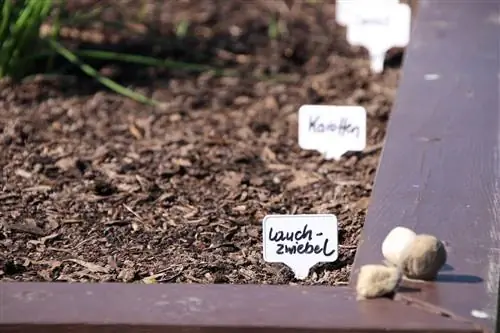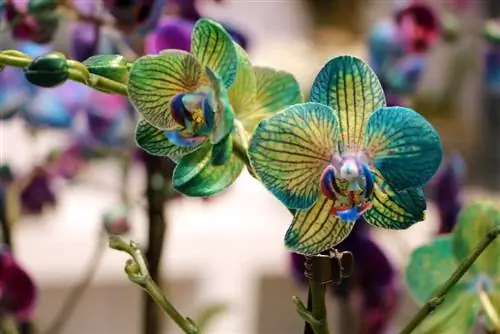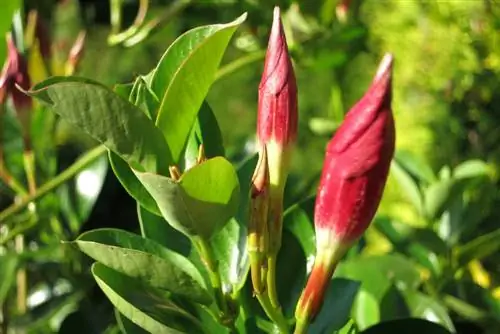- Author admin [email protected].
- Public 2023-12-17 03:39.
- Last modified 2025-01-24 12:45.
With a blue diamond, a southern ambience enters the garden during the summer peak season. Numerous bees, hoverflies and butterflies cavort on the violet-blue flowering, intensely fragrant spikes. Unfortunately, this glory will be over again in October. Should you cut the shoots immediately after flowering, or is there a more convenient time?
When to cut the blue diamond?
For the plant, which grows up to one meter high, there is only one season that is suitable for pruning: early spring. Another date is out of the question. When exactly depends on the weather. In some years there is still severe frost in March, which is why the days after are better. Otherwise, the end of February or beginning of March is the ideal time for cutting. If, contrary to expectations, an icy cold phase occurs after pruning, the plant, which can no longer provide adequate winter protection itself, definitely needs a warming cover, for example fir branches, autumn leaves, burlap, plant fleece or, if necessary, a piece of cardboard.
Why not prune after flowering?
Here are the reasons why the blue rue should under no circumstances be cut in autumn:
- Plant Origin: Steppes of the Near East
- Climate in the home areas: warm temperate to subtropical
- does not tolerate severe frost
- Winter hardiness zone Z7: -12 to -17° C
- increased risk of freezing to death when pruning in autumn
- wilted leaves protect against cold
- additional winter cover required in harsh areas
Why cut the blue diamond?
There are several names for the multi-shooting plant. The scientific term for the plant from the mint family is Perovskia atriplicifolia, whereas some gardeners know the plant under the following names:
- Silverbush
- Russian Sage
- Feathery Perovskia
- Silver Perovskia
It is a typical subshrub, in a sense a plant form between a perennial and a bushy tree. The flowers generally only form on annual shoots. Subshrubs, which also include rosemary, sage and thyme, quickly become woody if repruning is neglected. Sprout parts near the ground gradually become thicker and develop a solid bark over time. Neither leaves nor flowers grow here, while new growth occurs above and dies off again after each flowering season. Only strong pruning can protect sub-shrubs from becoming bare in the lower areas. As for the silverbush, annual pruning causes the canes to produce silver-gray leaves and purple flowers from the base to the tips of the shoots.
Suitable type of pruning
Only one type of cut meets the requirements so that the silver bush maintains a compact appearance in the long term: a rigorous rejuvenation cut that includes all shoots. The scissors are placed close to the base so that after cutting back only stubs of a maximum of 10 cm remain. It is very likely that the non-woody shoots will have already frozen over the course of the winter. This cold damage is removed in one operation during the pruning measure carried out in the spring.
Which scissors to use for pruning?
The choice is yours. You can prune the blue diamond either with pruning shears, also known as rose or vine shears, or with shrub shears. When using secateurs, pruning takes a little more time because this cutting tool only allows you to cut a single rod at a time. When using mechanical shrub shears that are used with both hands, the work progresses more quickly. Every time you cut with the scissors with the longer blades, several stems fall over. Motorized hedge trimmers are less suitable for the silver bush.
Note:
To sharpen secateurs, you can use a water stone instead of a traditional whetstone. The usual grinding method for kitchen knives also makes garden shears nice and sharp again.
How to cut back blue diamond
You need:
- Garden or hedge trimmer
- Gardening Gloves
- Basket, bin or bag for waste
- if necessary knee pads or knee pads
Step-by-step instructions:
- choose a rain-free and frost-free day
- Sharpen the blades of the secateurs if necessary
- Provide a container for the cutting waste
- maybe spread a pad on the floor for your knees
- grasp one stem with one hand and cut off the bottom with the other
- or trim several tendrils at once using shrub shears
- only leave woody shoots up to a height of 10 cm
- collect severed plant stems in the container
- Dispose of clippings (composter or green waste area)
Tip:
A kneeling position when gardening close to the ground protects your back and relieves the strain on your joints. Using a knee pillow will keep your knees or pants clean.
Where do the cut stems go?
The cuttings of the blue rue are far too good for the garbage can. After all, this waste consists exclusively of organic substances. Under the influence of oxygen, heat and moisture, the biomass matures into nutrient-rich fertilizer and soil-improving humus soil. If you do your own composting, you certainly don't have to think long about what to do with the cut stems.
Because the stems of the blue rue are relatively thick, shredding them beforehand is recommended. If the stems remain as they are, they will take a long time to break down into fine crumbs in the compost. If you don't have a shredder, you should at least cut the clippings into smaller pieces with scissors so that decomposition in the composter doesn't take too long. If you do not have the opportunity to produce humus yourself, green waste areas are ideal buyers for clippings.
You should avoid these mistakes when pruning the blue diamond
- cut in autumn after flowering (lack of heat protection in winter)
- generally a cut back too early, followed by another period of frost
- Rainy weather promotes rot
- Break or bend branches instead of cutting them
- leave stems standing for too long (risk of balding)
Cut off flowering branches
The long, mostly straight inflorescences with panicles sprouting from the sides create beautiful bouquets that exude a pleasant scent. Blue rue flowers last quite a long time in the vase. With creative ideas and a little skill you can create pretty wreaths or other containers. However, when cutting flowering vines, you should be careful never to completely remove the upper parts of the plant. Limit yourself to individual branches that you remove from different places so that sufficient winter protection remains. The plant also no longer looks attractive if it has large gaps during the flowering season or has no flowers at all.






